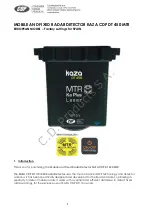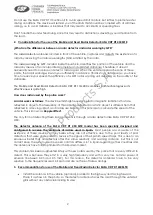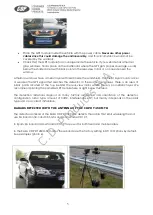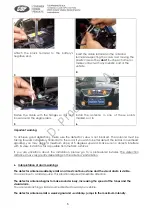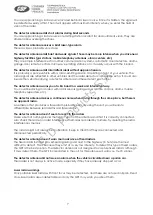
7
You are approaching a radar source located behind a rise or curve. Since it is hidden, the signal will
be detected weakly at first. Then it will appear with maximum intensity when you enter the field of
vision of the radar.
The detector antenna emits short alarms during brief seconds.
You are approaching a radar source or emitting station located far and outside its vision. They are
simple radio wavelength echoes.
The detector antenna receives a brief laser-type alarm.
There is a laser, probably very close.
The detector antenna emits brief and weak signals. These may be more intense when you drive near
highway facilities (gas stations, mobile telephony antennas, urban centers, etc.)
They are simple interferences from other communication systems, automatic door detectors, alarms,
garage-door remote controls, microwave emitting stations, etc. It usually occurs with the K band.
The detector antenna emits intermittent alerts without apparent reason.
It is probably a police vehicle with a radar-emitting device circulating in front of your vehicle. The
radar signals are reflected in other vehicles and the radar detector captures the echo. It could also
be another vehicle carrying a detector antenna and these detect each other.
The detector antenna warns you of a KA band in a weak and intermittent way.
You could be driving in an area with radar sensors (garage-door remote controls, alarms, mobile
telephony repeaters, etc.)
The detector antenna makes a continuous noise when driving through the same place, but there is
no apparent radar.
An emission that produces a false alarm probably exists. By using the unit, you will learn to
differentiate between real alarms and false alarms.
The detector antenna doesn't seem to react to the radars.
Make sure that nothing blocks the field of vision of the antenna and that it is correctly connected.
Also check there are no radar interferences memories recorded by mistake. Try deleting the radar
interferences memory.
The radars might not always be in operation. Keep in mind that they are connected and
disconnected periodically.
The detector antenna doesn't warn me in advance of fixed radars.
The fixed radars installed in overhead signaling and next to the highway (in huts) are the most
difficult to detect. This is because they emit at a very low intensity. To detect this type of fixed radars,
the GPS is the best solution. The detector antenna is not designed to capture fixed radars, although
it may detect them. The GPS incorporated in the unit for this purpose will warn you much sooner.
The detector antenna did not issue an alarm when the vehicle circulated near a police car.
Their radar is not always in active mode, especially if they have already stopped a car.
Laser radar warnings.
Only portable laser radars with front focus may be detected, and these are not used in Spain. Fixed
cross-laser radars are undetectable and only the GPS may warn you about them.
C.D. Products S.A.

